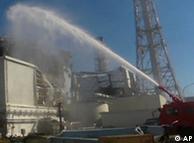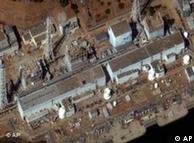DISASTERS | 20.03.2011
Fukushima engineers cool reactors, progress on power restoration
Crews battling a potential meltdown at the Fukushima nuclear plant in Japan reconnected a power supply, enabling cooling systems to be restarted after being damaged during a series of explosions earlier this week.
Facility operator Tokyo Electric Power Company said it had attached cable to the plant's number two reactor early on Sunday. This restored power to the control room, lights, and cooling systems to reactor number one, which is connected to the second reactor by cable. Work continues on getting electricity restored to the remaining reactors.
The aim is to get power restored to water pumps in four of the plant's six reactors to cool overheated fuel rods and prevent a full-blown nuclear meltdown.
On Sunday, a government spokesman said the damage to the plant was such that it would eventually have to be scrapped.
Japan was hit by a 9.0 magnitude earthquake on March 11, which was followed by a tsunami that flooded the Fukushima building and damaged crucial electrical systems - causing a catastrophic rise in temperature and pressure.
Three hundred engineers have been struggling inside the danger zone to salvage the six-reactor Fukushima plant in the world's worst nuclear crisis since Chernobyl 25 years ago.
"I think the situation is improving step by step," Deputy Chief Cabinet Secretary Tetsuro Fukuyama told a news conference.
Progress on most dangerous reactor
There was some encouragement as the most critical reactor - number three - was stabilized early on Sunday, after it was doused for some 13 hours with 2,000 metric tons of water.
Fears had been high that water levels would drop too much in reactor three's fuel pool. Reactor three is the only reactor at the plant to use highly toxic plutonium in its fuel mix.
The operation has been "successful to some extent," said Japanese Chief Cabinet Secretary Yukio Edano.
Specially equipped fire trucks on Sunday also doused reactor number four, where water levels had also fallen. The plan is to restore power to reactors three and four after it has been restored to the first two reactors.
There were reports that the spraying operations were partly responsible for holding back the work to restore power to the reactors.
The Kyodo news agency reported that temperatures at the least critical reactors, number five and number six, were returning to normal, with diesel generators being used to power cooling systems.
Tests show food contaminated
There was also mounting evidence that radiation leaking from the plant had reached the food chain.
Levels exceeding national safety standards were found in milk and spinach from farms in the surrounding region, while Taiwanese officials said beans imported from Japan also showed heightened radioactivity levels.
The Japanese Health Ministry says tests have also detected additional types of radiation-tainted vegetables, in more places.
Ministry official Yoshifumi Kaji said Sunday that tests found excess amounts of radioactive elements on canola and chrysanthemum greens, in addition to spinach. He said the areas where the tainted produce was found included three prefectures that previously had not recorded such contamination.
Kaji said it was possible that some tainted foods may already have been sold. He also said that the government ordered shipments of milk from Fukushima, where the plant is located, to be halted after finding tainted milk at four farms out of 37 tested.
Very low levels of radioactive iodine have also been found in tap water in Tokyo, which lies about 240 kilometers (150 miles) to the south of the plant.
The total number of people confirmed dead in Japan's earthquake and tsunami now stands at over 8,000. More than 12,000 people were still unaccounted for, according to police.
But police also believe more than 15,000 people had been killed by the double disaster in Miyagi prefecture, one of four in Japan's northeast that took the brunt of the tsunami damage.
There was some good news reported from Japan however, as an 80-year-old woman and a 16-year-old youth were pulled from the rubble in the town of Ishinomaki, nine days after the quake and ensuing tsunami swept the northeast part of the country.
Author: Matt Zuvela, Ben Knight (AFP, dpa, Reuters, AP)
Editor: Sean Sinico
dw




No comments:
Post a Comment